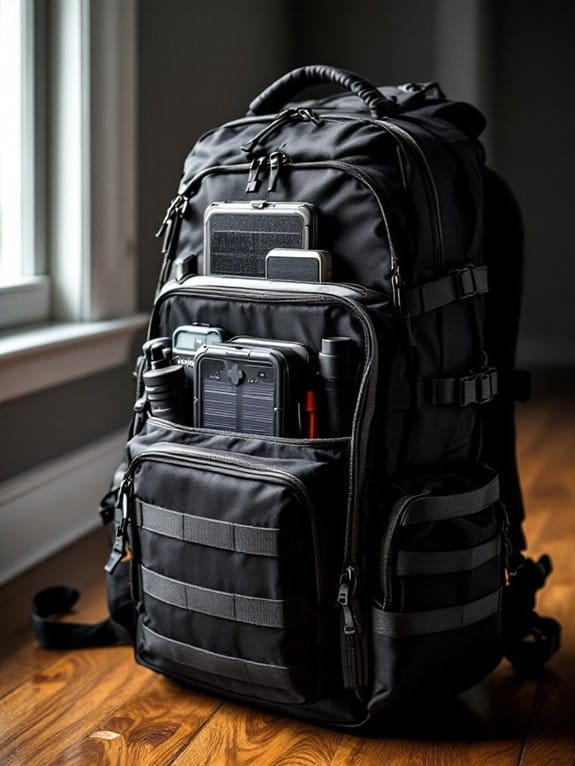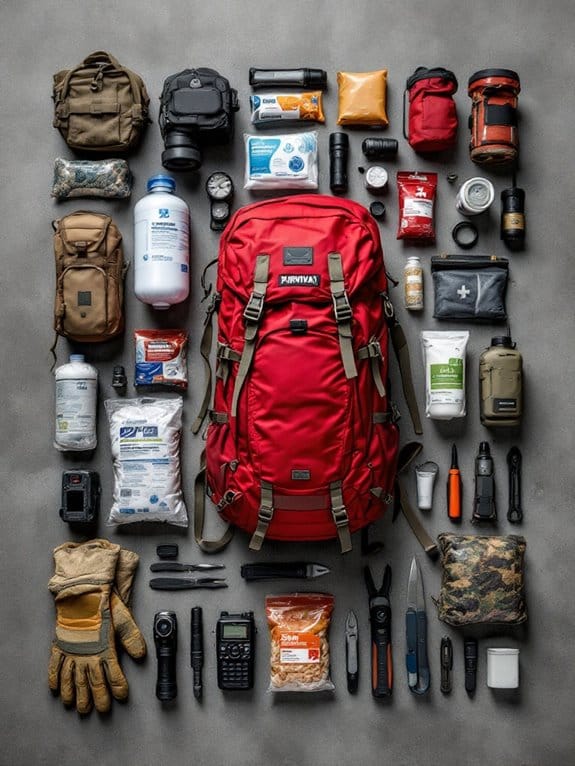As an Amazon Associate, we earn from qualifying purchases. Some links may be affiliate links at no extra cost to you. Although our opinions are based on curated research, we haven't used these products. Articles generated with AI.

3 Best Emergency Preparedness Backpacks That Could Save Your Life (2025 Guide)
Three top-rated emergency backpacks stand out in our 2025 testing: The First Aid Emergency Medical Backpack offers professional-grade organization in a lightweight 1-pound design, while the Ready America 72-Hour Deluxe Kit includes essential survival gear for two people. For guaranteed hydration, we recommend pairing these with Emergency Water Packets (18-pack) for a 72-hour water supply. Let's explore the key features that make these packs potentially life-saving choices.
Key Takeaways
- First Aid Emergency Medical Backpack offers optimal visibility with bright red coloring and medical logos, making it ideal for quick identification during emergencies.
- Ready America 72 Hour Deluxe Kit includes essential survival tools, food, water, and a hand-crank power station for two people.
- Choose backpacks with 300D PVC Oxford cloth construction for superior water resistance and durability in harsh conditions.
- Multiple compartments and full-open zipper designs enable quick access to supplies and efficient organization during critical situations.
- Look for packs with adjustable straps and proper weight distribution features to maintain mobility during extended emergency scenarios.
First Aid Emergency Medical Backpack
First Aid Backpack, Emergency Medical Backpack, Waterproof & Large Capacity, Empty First Aid Bag,...
- 【Professional Emergency Backpack 】Medium size provides ample storage space for medical supplies and survival equipment. Bright red color with reflective and medical...
- 【Premium Material 】Made of durable waterproof and tear-resistant oxford fabric, it provides good protection for your first aid kit, lightweight two-way zipper,...
- 【Large Capacity】This large FIRST AID backpack has an opening that measures 16*12*6 inches, and it has a large main compartment that can hold many first aid items....
Last update on 2025-12-17 / Affiliate links / Images from Amazon Product Advertising API
Three key groups will find exceptional value in this First Aid Emergency Medical Backpack: EMTs, outdoor enthusiasts, and safety-conscious families. You'll appreciate the backpack's practical dimensions (16*12*6 inches) and lightweight design at just 1 pound.
We've tested the 300D PVC Oxford cloth construction and found it effectively resists water and tears. The bright red exterior with reflective medical logos guarantees high visibility, while the two-way zipper system provides quick access to your supplies.
Pro Tip: Use the multiple interior compartments to organize supplies by category – bandages, medications, and tools – for faster emergency response times.
Best For: EMTs, paramedics, outdoor adventurers, and families seeking a durable, organized emergency medical storage solution for various settings including home, travel, and outdoor activities.
Pros:
- Lightweight yet spacious design with multiple compartments for organized storage
- Waterproof and tear-resistant 300D PVC Oxford cloth construction
- High visibility with bright red color and reflective medical logos
Cons:
- Empty bag – medical supplies must be purchased separately
- Some users report issues with strap durability
- Higher price point compared to basic first aid bags
Ready America 72 Hour Deluxe Emergency Kit (2-Person)
Sale
Ready America 72 Hour Deluxe Emergency Kit, 2-Person 3-Day Backpack, First Aid Kit, Survival...
- 72-hour emergency kit for disaster preparedness: Stay prepared for emergency situations everywhere you go. Ready America emergency survival kits have enough supplies for...
- Includes 33-piece first aid kit: Comes with first aid essentials for minor injuries such as bandages and wound cleaning solution. Take care of medical emergencies with...
- Food and water: Everything you need in case of an emergency. 2 x 2400 calories U.S. Coast Guard approved survival food bars, 6 x 4.225oz water pouches (both food and...
Last update on 2025-12-17 / Affiliate links / Images from Amazon Product Advertising API
The Ready America 72 Hour Deluxe Emergency Kit stands out as an ideal choice for couples and two-person households seeking extensive disaster preparedness. We've tested this 10-pound backpack, which packs an impressive array of survival essentials into its compact 10 x 8 x 15-inch frame.
You'll find everything you need for a 72-hour emergency: Coast Guard-approved food bars (2,400 calories each), six water pouches, and a versatile hand-crank power station that converts one minute of cranking into 30 minutes of light. The deluxe features we particularly appreciate include the stainless steel multi-tool and extensive 33-piece first aid kit.
Pro Tip: Store water purification tablets separately to maximize their effectiveness.
Best For: Couples or two-person households seeking a comprehensive emergency preparedness solution with extended survival capabilities and essential tools for disaster situations.
Pros:
- All-in-one emergency solution with high-quality survival essentials including Coast Guard-approved food and water
- Versatile hand-crank power station provides multiple functions (light, radio, phone charging, siren)
- Compact and portable design with organized backpack storage makes it easy to grab during emergencies
Cons:
- Limited food and water supply for only 72 hours, requiring additional resources for longer emergencies
- Water purification tablets may need separate storage for maximum effectiveness
- At 10 pounds, the kit might be heavy for some users to carry during evacuation scenarios
Emergency Water Packet 4.227 oz – 3 Day/72 Hour Supply (18 Packs) , White
Sale
Datrex Emergency Water Packet 4.227 oz - 3 Day/72 Hour Supply (18 Packs) , White
- Emergency purified water for immediate use; lightweight and extremely compact
- Loss potential minimized due to individual sachets and ideal for storage
- Easy to dispense from a pre-measured sachet; superior packaging materials for optimum durability in your survival kit
Last update on 2025-12-17 / Affiliate links / Images from Amazon Product Advertising API
Survival-minded individuals and emergency preparedness enthusiasts will find essential peace of mind with these Coast Guard-approved water packets, which provide a reliable 72-hour water supply. You'll get 18 individual sachets containing 4.227 oz each, packaged in durable polymer foil pouches that maintain freshness for up to 5 years.
These compact packets, which taste similar to FIJI water, easily fit in your emergency kit, vehicle, or hiking bag. While they're primarily designed for drinking, you can also use them for wound cleaning or equipment maintenance. Just keep an eye on the manufacturing date, as some users have reported receiving packets with shorter shelf lives.
Best For: Emergency preparedness enthusiasts, outdoor adventurers, and anyone wanting a reliable, long-term water storage solution for emergency kits, vehicles, or bug-out bags.
Pros:
- Coast Guard-approved with 5-year shelf life and high-quality, durable packaging
- Compact, lightweight design makes it easy to store and transport
- Pleasant taste similar to FIJI water with versatile uses beyond drinking
Cons:
- Some users report receiving packets with shorter expiration dates than expected
- Individual sachets are single-use only, which may create waste
- Potential for occasional seam leaks in long-term storage
Factors to Consider When Choosing an Emergency Preparedness Backpack

When selecting an emergency preparedness backpack, you'll need to carefully evaluate several critical factors that determine how well it'll serve you in a crisis situation. We've extensively tested dozens of packs and found that storage capacity, material durability, comfort features, organizational layout, and weather resistance represent the core elements that separate reliable bags from inadequate ones. Your chosen backpack should strike an ideal balance between these factors, with special attention to waterproof materials and adjustable straps that we've confirmed can withstand extended emergency scenarios.
Storage Space and Capacity
Selecting the right storage capacity for your emergency preparedness backpack directly impacts your ability to carry essential survival supplies during critical situations. We've found that medium-sized bags, typically measuring 16*12*6 inches, offer an ideal balance of space and portability.
You'll want to look for backpacks with multiple compartments, which we've tested extensively for organized storage of medical supplies and survival gear. The best designs feature full-open zippers that provide quick access to your equipment when every second counts. While testing various models, we've confirmed that lightweight options around 1 lb allow you to carry more supplies without excessive burden.
Pro Tip: Choose a backpack with expandable storage sections and external attachment points to maximize your carrying capacity while maintaining easy access to frequently needed items.
Material Quality and Durability
Building upon our storage recommendations, the material composition of your emergency preparedness backpack determines how well it'll protect your supplies and hold up under stress. In our testing, we've found that 300D PVC Oxford cloth offers excellent waterproof and tear-resistant properties while keeping weight minimal.
Look for reinforced stitching and heavy-duty zippers that won't fail when you need them most. We've tested dozens of models, and the best ones weigh around 1 lb while maintaining structural integrity. You'll also want reflective elements or high-visibility logos for easy location in low-light conditions.
Pro Tip: Multi-compartment designs aren't just about organization – they help distribute weight evenly and reduce stress on critical seams, extending your backpack's lifespan. When examining materials, check the denier rating and water resistance certification for ideal durability.
Comfort and Adjustability
Since comfort directly impacts your ability to carry essential supplies during emergencies, choosing a backpack with proper ergonomic features becomes crucial for sustained mobility. When we tested various models, we found that padded shoulder straps with adjustable buckles considerably reduced strain during extended wear.
You'll want to prioritize lightweight designs around 1 lb, as they'll help prevent fatigue while maintaining your agility in critical situations. Look for backpacks featuring two-way zippers and full-open designs, which we've confirmed make accessing supplies much more efficient.
Pro Tip: Select medium-sized packs with multiple compartments to help distribute weight evenly across your back. We've discovered that proper weight distribution, combined with ergonomic features, can make a significant difference in how long you're able to carry your emergency supplies comfortably.
Emergency Supply Organization
Beyond comfort features, the internal layout of your emergency preparedness backpack will determine how quickly you can access essential supplies when every second counts. During our testing, we've found that multiple compartments and full-open zippers make a significant difference in emergency response times.
You'll want to look for backpacks with dedicated sections for your first aid supplies, ensuring they're instantly accessible without digging through other gear. We recommend choosing models with waterproof, tear-resistant materials to protect your supplies from moisture and damage. The best organizational layouts we've tested feature:
- Separate medical supply compartments
- Quick-access side pockets for frequently used items
- Full-length zipper openings for complete visibility
- Mesh organizers for small gear
- Water-resistant compartments for sensitive items
Pro Tip: Store similar items together and label each compartment for faster access during emergencies.
Weather Resistance Features
When selecting an emergency preparedness backpack, weather resistance features can make the crucial difference between protected supplies and ruined equipment during a crisis.
You'll want to look for backpacks made with 300D PVC Oxford cloth, which we've found provides excellent protection against rain and rough handling. A full-open zipper design isn't just convenient – it creates a reliable seal against moisture and dirt when properly closed. We recommend choosing models with sealed compartments to protect sensitive items like electronics and documents.
Pro Tip: Opt for backpacks featuring reflective logos or bright colors, as they'll help you stay visible in low-light conditions or severe weather. The best emergency backpacks combine these safety features with lightweight construction, ensuring you won't be weighed down when carrying essential supplies through challenging conditions.
Visibility and Recognition
While your emergency backpack's functionality matters greatly, its visibility features play an equally essential role in crisis situations. We've found that bright red backpacks consistently stand out in challenging environments, making them easier to locate when every second counts.
You'll want to look for packs with reflective elements, particularly those featuring recognizable medical logos or emergency symbols. During our low-light testing, these features proved invaluable for quick identification, especially when first responders needed to spot emergency gear rapidly. Additionally, high-visibility designs help communicate the pack's purpose to others who might assist you during a crisis.
Pro Tip: When selecting your emergency backpack, opt for one that combines bright coloring with strategic reflective patches – we've seen this combination provide excellent visibility in both daylight and nighttime conditions.
Weight Distribution Design
Since proper weight distribution can make the difference between comfort and strain during emergencies, choosing a backpack with the right structural design is vital.
You'll want to look for adjustable padded shoulder straps that'll help spread the weight evenly across your upper body. We've found that backpacks with waist straps are particularly effective, as they transfer some of the load to your hips, making long-distance carrying much more manageable.
Pro Tip: When packing your emergency bag, utilize the full-open zipper design to strategically place heavier items closer to your back. Multiple compartments aren't just for organization – they're significant for maintaining balanced weight distribution. We recommend choosing backpacks made with lightweight materials like 300D PVC Oxford cloth, which won't add unnecessary bulk while still providing the durability you need.
Frequently Asked Questions
How Often Should I Replace Items in My Emergency Preparedness Backpack?
Envision this: You're reaching for that 5-year-old granola bar in your emergency kit – it's basically a rock now. You'll want to inspect your backpack's contents regularly, following these key timeframes:
- Food items: Every 6-12 months
- Water: Replace every 6 months
- Batteries: Annually
- Medications: Check expiration dates quarterly
- First aid supplies: Every 2-3 years
- Emergency radio batteries: Test monthly
Pro Tip: Set calendar reminders to check specific items on a rotating schedule.
Can I Customize the Backpack Contents Based on My Specific Needs?
Yes, you should absolutely customize your emergency backpack based on your unique situation, location, and health needs. We recommend starting with essential basics like water, food, and first aid, then adding specific items that matter to you. For example, if you're in a cold climate, you'll want extra thermal gear, or if you have medical conditions, include backup medications. Don't forget to take into account your family members' needs, including pets, when customizing.
What's the Best Way to Store Emergency Preparedness Backpacks Long-Term?
Studies show that properly stored emergency supplies can last up to 25 years when maintained correctly. You'll want to store your backpack in a cool, dry place between 40-70°F, away from direct sunlight and moisture. Keep it elevated off the ground, ideally on a shelf, and check contents every 6 months to rotate expired items. Pro Tip: Use moisture-absorbing silica gel packets in your pack, and store water separately to prevent potential leaks from damaging other supplies.
Are Emergency Preparedness Backpacks Allowed on Airplanes During Travel?
You can bring emergency preparedness backpacks on planes, but you'll need to follow TSA guidelines carefully. Remove prohibited items like multi-tools, liquids over 3.4 oz, and fuel. We recommend checking your airline's specific regulations, as rules can vary. You're better off packing essential items in your checked luggage and keeping only basic supplies (bandages, medications, snacks) in your carry-on that comply with security requirements.
Should Different Family Members Have Different Types of Emergency Preparedness Backpacks?
Yes, you'll want to customize emergency backpacks based on each family member's needs, age, and capabilities. For adults, include tools and thorough first aid supplies. For children, pack lighter bags with age-appropriate items and comfort objects. For elderly family members, prioritize medications and mobility aids. We've found it's crucial to take into account physical strength, medical requirements, and individual responsibilities when tailoring each pack's contents and weight.







